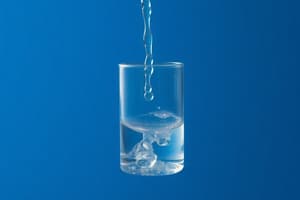Podcast
Questions and Answers
Isotonic solutions cause net movement of water molecules across the cell membrane.
Isotonic solutions cause net movement of water molecules across the cell membrane.
False (B)
What is osmotic pressure a measure of?
What is osmotic pressure a measure of?
- The concentration of solute in the solution
- The temperature of a solvent
- The tendency of a solution to take in water by osmosis (correct)
- The force of gravity acting on water
Define hypotonic solution.
Define hypotonic solution.
A solution with a lower solute concentration outside the cell than inside.
A solution that has a higher solute concentration than the fluids inside the cell is called __________.
A solution that has a higher solute concentration than the fluids inside the cell is called __________.
Match the following types of solutions with their characteristics:
Match the following types of solutions with their characteristics:
What happens to a cell when the solution outside is isotonic?
What happens to a cell when the solution outside is isotonic?
Active transport is the passage of a substance from its higher to lower concentration through a living cell membrane.
Active transport is the passage of a substance from its higher to lower concentration through a living cell membrane.
What happens to a red blood cell placed in a hypertonic solution?
What happens to a red blood cell placed in a hypertonic solution?
Osmotic pressure is equal to the pressure required to allow the passage of pure solvent into the solution.
Osmotic pressure is equal to the pressure required to allow the passage of pure solvent into the solution.
What is the direction of active transport?
What is the direction of active transport?
Match the following terms with their definitions:
Match the following terms with their definitions:
What is the function of the cell wall in plant cells?
What is the function of the cell wall in plant cells?
When a cell is fully distended, it is called ______________________.
When a cell is fully distended, it is called ______________________.
A semi-permeable membrane allows the passage of solute molecules.
A semi-permeable membrane allows the passage of solute molecules.
The term used to describe the relative concentration of solutions that affect diffusion is __________.
The term used to describe the relative concentration of solutions that affect diffusion is __________.
What is the energy source for active transport?
What is the energy source for active transport?
Flashcards are hidden until you start studying
Study Notes
Osmotic Pressure
- Osmotic pressure is the minimum pressure required to prevent the passage of pure solvent into a solution when the two are separated by a semi-permeable membrane.
- It is equal to the weight or pressure that nullifies the entry of water into a solution.
Tonicity
- Tonicity refers to the relative concentration of solutions that determines the direction and extent of diffusion.
- There are three types of solutions based on tonicity: isotonic, hypotonic, and hypertonic.
Isotonic Solution
- In an isotonic solution, the concentration of water molecules and solute on either side of the cell membrane is the same.
- There is no net movement of water molecules across the cell membrane in an isotonic solution.
Hypotonic Solution
- In a hypotonic solution, the solution outside the cell has a lower solute concentration than the fluids inside the cell.
- Water molecules from outside the cell move into the cell (endosmosis) in a hypotonic solution.
Hypertonic Solution
- In a hypertonic solution, the solution outside the cell has a higher solute concentration than the fluids inside the cell.
- Water molecules from the interior of the cell move out (exosmosis) in a hypertonic solution.
Effects of Tonicity on Cells
- In an isotonic solution, cell shape and size remain unchanged.
- In a hypertonic solution, cells shrink in size and lose shape.
- In a hypotonic solution, cells slightly enlarge or even burst.
Plant Cells
- Plant cells have a rigid cell wall that resists bulging and protects the delicate cellular parts inside.
- Turgidity, plasmolysis, and flaccidity are phenomena related to the behavior of plant cells in varying external fluid environments.
Active Transport
- Active transport is the passage of a substance from lower to higher concentration through a living cell membrane using energy from the cell.
- Active transport is in a direction opposite to that of diffusion.
- Certain nutrients such as ions of nitrates, sulphates, potassium, zinc, and manganese cannot pass through the cell membrane of root cells easily and require active transport.
Studying That Suits You
Use AI to generate personalized quizzes and flashcards to suit your learning preferences.



